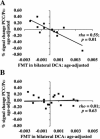Correlations of striatal dopamine synthesis with default network deactivations during working memory in younger adults
- PMID: 20578173
- PMCID: PMC3176660
- DOI: 10.1002/hbm.21081
Correlations of striatal dopamine synthesis with default network deactivations during working memory in younger adults
Abstract
Age-related deficits have been demonstrated in working memory performance and in the dopamine system thought to support it. We performed positron emission tomography (PET) scans on 12 younger (mean 22.7 years) and 19 older (mean 65.8 years) adults using the radiotracer 6-[(18)F]-fluoro-L-m-tyrosine (FMT), which measures dopamine synthesis capacity. Subjects also underwent functional magnetic resonance imaging (fMRI) while performing a delayed recognition working memory task. We evaluated age-related fMRI activity differences and examined how they related to FMT signal variations in dorsal caudate within each age group. In posterior cingulate cortex and precuneus (PCC/Pc), older adults showed diminished fMRI deactivations during memory recognition compared with younger adults. Greater task-induced deactivation (in younger adults only) was associated both with higher FMT signal and with worse memory performance. Our results suggest that dopamine synthesis helps modulate default network activity in younger adults and that alterations to the dopamine system may contribute to age-related changes in working memory function.
Copyright © 2010 Wiley-Liss, Inc.
Figures





References
-
- Alexander GE,DeLong MR,Strick PL ( 1986): Parallel organization of functionally segregated circuits linking basal ganglia and cortex. Annu Rev Neurosci 9: 357–381. - PubMed
-
- Apud JA,Mattay V,Chen J,Kolachana BS,Callicott JH,Rasetti R,Alce G,Iudicello JE,Akbar N,Egan MF,Goldberg TE,Weinberger DR ( 2007): Tolcapone improves cognition and cortical information processing in normal human subjects. Neuropsychopharmacology 32: 1011–1020. - PubMed
-
- Backman L,Ginovart N,Dixon RA,Wahlin TB,Wahlin A,Halldin C,Farde L ( 2000): Age‐related cognitive deficits mediated by changes in the striatal dopamine system. Am J Psychiatry 157: 635–637. - PubMed
Publication types
MeSH terms
Substances
Grants and funding
LinkOut - more resources
Full Text Sources
Medical

